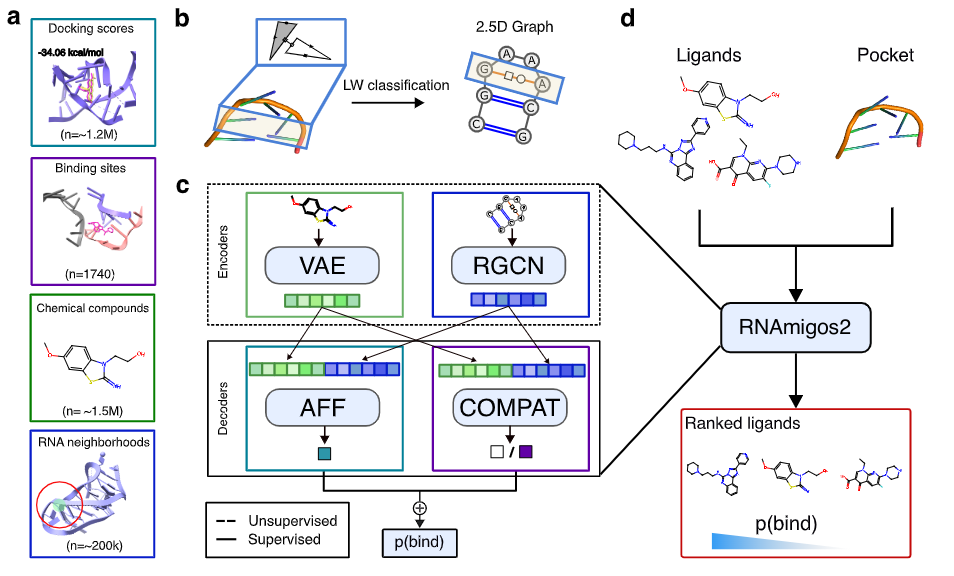Welcome on RNAmigos 2.0 !
RNAmigos is a virtual screening tool : given the binding site of a target and a library of chemical compounds, it ranks the compounds so that better ranked compounds have a higher chance to bind the target. It is based on a machine learning model using the PyTorch framework and was trained leveraging unsupervised and synthetic data. It was shown to display similar enrichment factors to docking while running in a fraction of the time. A detailed description of the tool is available on BioRxiv.
If you find this tool useful, please cite
@article{carvajal2023rnamigos2,
title={RNAmigos2: Fast and accurate structure-based RNA virtual screening with semi-supervised graph learning and large-scale docking data},
author={Carvajal-Patino, Juan G and Mallet, Vincent and Becerra, David and Ni{\~n}o Vasquez, Luis Fernando and Oliver, Carlos and Waldisp{\"u}hl, J{\'e}r{\^o}me},
journal={bioRxiv},
pages={2023--11},
year={2023},
publisher={Cold Spring Harbor Laboratory}
}The easiest way to use the tool is to use Google Colab.
You will need to provide a cif file, a binding site in the form of a list of binding pocket nodes and a list of ligand smiles.
A local use of the tool is also possible by following the next steps. NOTE: This has been tested on Linux Ubuntu 24 and Mac OS 13 and 14. No special hardware requirement, inference code runs on common desktops and laptops.
First, create a conda environment:
git clone https://github.com/cgoliver/rnamigos2.git
cd rnamigos2/
conda create -n rnamigos2
conda activate rnamigos2
pip install -r requirements.txtTo run RNAmigos2.0 on your own target and ligands, use the rnamigos/inference.py script.
You will need to provide the following:
- Path to an mmCif file
- Path to a .txt file with one SMILES string per line
- A list of binding site residue identifiers
Now you can just run the inference script to get a score for each ligand in your SMILES .txt file.
Taking example structure and ligand file from /sample_files, selecting residues 16-20 of chain A as the binding
site, the corresponding command is :
python rnamigos/inference.py cif_path=sample_files/3ox0.cif \
pdbid=3ox0 \
residue_list=\[A.20,A.19,A.18,A.17,A.16\] \
ligands_path=sample_files/test_smiles.txt \
out_path=scores.txt
Once this executes (~10 seconds) you will have scores.txt that looks like this:
CCC[S@](=O)c1ccc2[nH]/c(=N\C(=O)OC)[nH]c2c1 0.2639017701148987
O=C(O)[C@@H](O)c1ccccc1 0.6267350912094116
CC(=O)Oc1ccccc1C(=O)O 0.6304176449775696
CN1[C@H]2CC[C@@H]1CC(OC(=O)[C@H](CO)c1ccccc1)C2 0.47674891352653503
...
The scores are between 0 and 1 with a higher score representing a better likelihood of binding.
NOTE: inference on user-provided structures has not been validated as it uses fr3d-python as a structure annotation backend which was not used in training. The models provided were trained on structures annotated by x3dna-dssr.
The steps necessary to reproduce results and figures are detailed in REPRODUCE.md.
